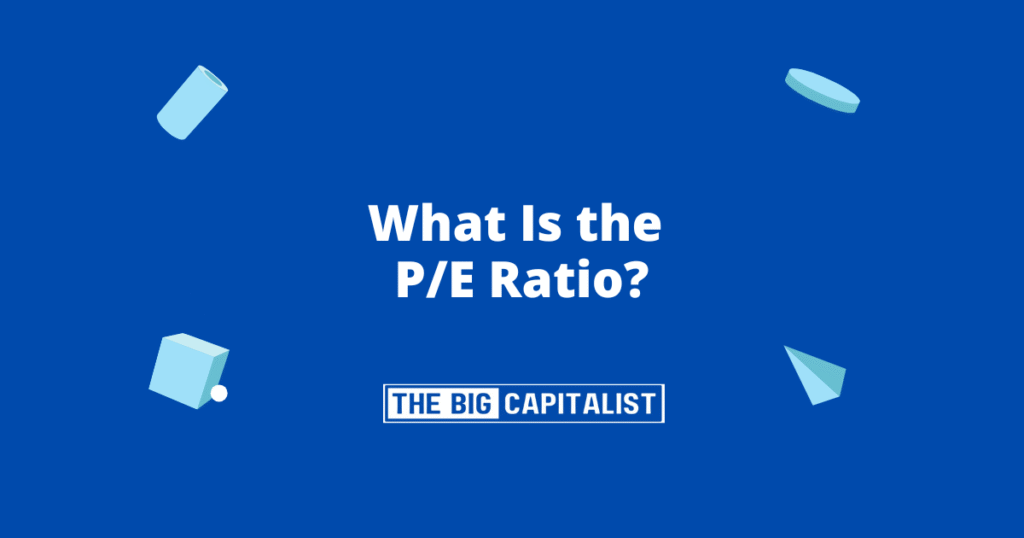When it comes to evaluating stocks, the price-to-earnings (P/E) ratio is often the first metric investors turn to—and for good reason. P/E ratio analysis is more than just a number. It reveals market feelings, growth hopes, and how companies compare to each other. In this article, we’ll explore how to dissect both trailing and forward P/E ratios, adjust for industry norms, and interpret what different P/E levels reveal about a company’s financial health. Whether you’re hunting for undervalued gems or seeking confirmation on high-flying growth stocks, mastering P/E ratio analysis will sharpen your ability to make informed investment choices. Let’s get started.
Here’s the formula:
P/E Ratio= Earnings per Share (EPS) /Market Value per Share
For example, if a company has a share price of $100 and its earnings per share is $5, the P/E ratio would be 20. This means investors are willing to pay $20 for every $1 of earnings the company generates. The P/E ratio thus serves as a shorthand for gauging market sentiment about a company’s earnings potential.
Why is the P/E Ratio Important?
Indicator of Market Expectations
The P/E ratio serves as a gauge of market expectations. A high P/E ratio might suggest that investors expect future growth and are willing to pay a premium for the stock. This optimism often reflects a belief in the company’s potential to expand, innovate, or capture additional market share. Conversely, a low P/E ratio could indicate that the market has lower expectations for future earnings growth or that the stock is undervalued, which might attract value investors looking for bargains.
Moreover, a high P/E might also signal overvaluation, where investor enthusiasm has driven the stock price beyond what the company’s fundamentals justify. Conversely, a low P/E might not always indicate a bargain; it could also reflect underlying issues within the company or sector. Therefore, while the P/E ratio is a useful indicator of market sentiment, it requires context for accurate interpretation.
Comparing Companies
The P/E ratio is a useful tool for comparing companies within the same industry. Since it provides a standard measurement, investors can use it to assess whether a stock is overvalued or undervalued compared to its peers. This comparison can be particularly helpful in industries where companies have similar business models and growth prospects. However, it’s essential to compare companies within the same sector, as different industries have varying average P/E ratios.
For instance, technology companies typically have higher P/E ratios compared to utility companies due to their growth prospects. Comparing a tech company’s P/E ratio to that of a utility company might lead to misleading conclusions. Therefore, understanding the industry norms and growth potential is crucial when using the P/E ratio for comparative purposes.
Assessing Growth Potential
While the P/E ratio can reflect market sentiment, it also offers insights into a company’s growth potential. A higher P/E might be justified for a company with strong growth prospects, suggesting that investors expect increased earnings in the future. Such expectations might be based on innovative products, expanding markets, or competitive advantages that set the company apart.
Conversely, a lower P/E could be more suitable for a company with stable, but slow growth, indicating a mature business that generates consistent earnings. However, it’s important to consider whether low growth is a temporary phase or indicative of broader challenges. In this way, the P/E ratio provides a starting point for deeper analysis into a company’s future prospects and strategic positioning.
Types of P/E Ratios
Investors often consider two main types of P/E ratios: the trailing P/E and the forward P/E. Each type offers a different perspective on a company’s earnings, guiding investors in their decision-making process.
Trailing P/E Ratio
The trailing P/E ratio is calculated using earnings from the past 12 months. It provides a historical perspective, reflecting how the company has performed recently. This backward-looking approach helps investors understand how the stock’s current price relates to actual past earnings, offering a grounded view of the company’s valuation. However, past performance is not always indicative of future results, especially in rapidly changing industries or economic conditions.
Despite its historical nature, the trailing P/E can be invaluable in identifying trends and patterns in a company’s earnings. It can also serve as a benchmark for assessing whether a company’s performance is improving or deteriorating over time. Nevertheless, relying solely on the trailing P/E without considering future prospects can lead to incomplete analyses.
Forward P/E Ratio
The forward P/E ratio uses projected earnings for the next 12 months. This version of the P/E ratio is more forward-looking and helps investors consider future earnings expectations. By focusing on anticipated earnings, investors can gauge whether a stock is priced appropriately based on its future potential. It’s important to note that these are estimates and can vary based on analysts’ predictions, which are subject to change due to market conditions or company-specific developments.
Forward P/E ratios can offer insights into a company’s strategic initiatives and growth plans, allowing investors to assess whether these expectations are realistic. However, the reliance on forecasts introduces uncertainty, making it essential for investors to evaluate the credibility of the projections. By understanding both trailing and forward P/E ratios, investors can develop a more comprehensive view of a company’s valuation.
Limitations of the P/E Ratio
While the P/E ratio is a valuable tool, it does have its limitations. Understanding these can help you make more informed investment decisions. It’s important to recognize that no single metric can capture the full complexity of a company’s financial health and market position.
Ignores Debt Levels
The P/E ratio does not account for a company’s debt. Two companies might have the same P/E ratio, but one could be carrying significantly more debt. This could impact the company’s financial health and future earnings potential, as high debt levels might lead to increased interest expenses and financial risk. Therefore, investors should consider a company’s debt load alongside the P/E ratio to gain a complete understanding of its financial situation.
A company with a high debt-to-equity ratio might face challenges in sustaining its earnings, affecting its attractiveness despite a favorable P/E ratio. By incorporating debt considerations into your analysis, you can avoid potential pitfalls and identify companies with robust financial foundations.
Not a Standalone Metric
The P/E ratio should not be used in isolation. It’s most effective when combined with other financial metrics and qualitative analysis. Investors should consider factors such as the company’s growth prospects, industry trends, and overall economic conditions. These additional insights can provide context and depth to the P/E ratio, enabling more informed investment decisions.
For instance, metrics like the PEG ratio (price/earnings to growth) or return on equity (ROE) can complement the P/E ratio, offering a more nuanced view of a company’s performance. By integrating multiple metrics, investors can cross-verify findings and build a more accurate picture of a company’s potential.
Impact of Accounting Practices
Different accounting practices can affect earnings calculations, which in turn impact the P/E ratio. It’s crucial to understand how a company’s earnings are reported to accurately interpret the P/E ratio. Variations in accounting methods, such as revenue recognition or depreciation policies, can lead to discrepancies in earnings figures.
Investors should be aware of these potential variations and investigate whether earnings are being presented in a way that accurately reflects the company’s financial health. By scrutinizing accounting practices, investors can identify potential red flags and ensure a more reliable interpretation of the P/E ratio.
How to Use the P/E Ratio in Investment Decisions
Value Investing
Value investors often look for stocks with low P/E ratios, believing they are undervalued by the market. This strategy involves identifying companies that have solid fundamentals but are trading at a discount compared to their intrinsic value. By seeking out undervalued stocks, value investors aim to profit from market corrections as prices eventually align with intrinsic value.
The challenge in value investing is distinguishing between genuinely undervalued stocks and those facing fundamental challenges. A thorough analysis of a company’s financial health, industry position, and management quality is essential to identify true value opportunities.
Growth Investing
Growth investors, on the other hand, might focus on stocks with higher P/E ratios, expecting them to deliver strong earnings growth in the future. They are often willing to pay a premium for the potential of higher returns, as these companies typically reinvest earnings to fuel expansion and innovation. By focusing on growth potential, investors aim to benefit from the compounding effects of rapidly increasing earnings.
However, growth investing comes with risks, as high P/E stocks can be more volatile and susceptible to market fluctuations. Investors should assess the sustainability of a company’s growth trajectory and its ability to maintain competitive advantages in a dynamic market.
Blended Approach
Some investors use a blended approach, considering both growth and value metrics. They may invest in companies with moderate P/E ratios that exhibit both solid earnings growth and reasonable valuations. This balanced strategy allows investors to benefit from growth opportunities while mitigating risks associated with overvaluation.
By diversifying across growth and value stocks, investors can create a more resilient portfolio that captures opportunities in varying market conditions. This approach requires a keen understanding of both growth potential and value metrics to make informed investment decisions.
Conclusion
The P/E ratio analysis is a crucial tool for investors, providing insights into market expectations, company valuations, and growth potential. While it is not without its limitations, understanding how to interpret and apply the P/E ratio can enhance your investment strategy. By integrating this metric with other financial indicators, investors can develop a more holistic view of a company’s prospects.
By combining the P/E ratio with other financial metrics and considering qualitative factors, you can make more informed decisions and increase your chances of success in the stock market. Remember, no single metric can provide a complete picture, so it’s essential to conduct thorough research and seek professional advice when necessary. In a world of complex financial markets, a well-rounded approach to analysis is key to achieving long-term investment success.
By mastering the P/E ratio, you can become a more knowledgeable and confident investor, ready to navigate the complexities of the financial markets. Armed with this understanding, you can approach investment opportunities with greater clarity and precision, ultimately leading to more successful outcomes.
Short FAQ: Understanding the P/E Ratio
Q1: What exactly is the P/E ratio?
A: The price-to-earnings (P/E) ratio divides a company’s share price by its earnings per share (EPS), showing how much investors pay for each dollar of earnings.
Q2: What’s the difference between trailing and forward P/E?
A: Trailing P/E uses actual EPS from the past 12 months (historical view), while forward P/E uses analysts’ projected EPS for the next 12 months (future-oriented).
Q3: What are the key limitations of relying on P/E?
A: It ignores debt levels, varies across industries, and can be distorted by accounting practices so always pair it with other metrics like PEG, ROE, or debt-to-equity.
Q4: How should I use P/E in my investment decisions?
A: Value investors target low P/Es for bargains, growth investors accept high P/Es for future upside, and a blended approach looks for moderate P/Es with solid growth prospects.
















